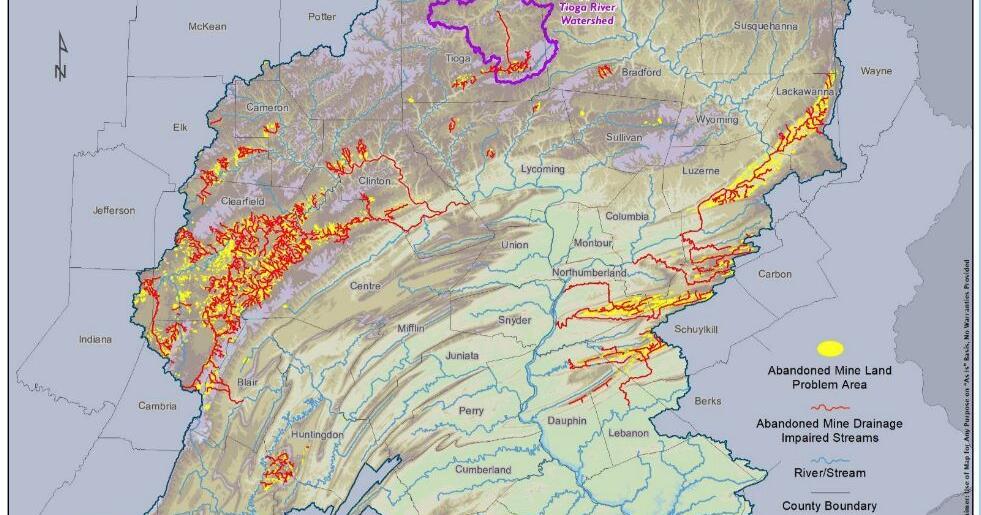afishinado
Moderator
Staff member

Last piece arrives; SRBC receives $68 million for Tioga River restoration
The last big piece needed for the restoration of the Tioga River restoration is now in place.

The fish are in that system (in the areas not AMD impacted) and are there and waiting.
That's what I thought but the PFBC ain't going to miss the opportunity to hurl mush bellies in there as quickly as they can.
Would be a great opportunity to restore a brook trout fishery but I imagine that opportunity will be missed, bummer.
Would probably be controversial in PA but installing a barrier to prohibit fish movement would be a thought. I'm originally from Schuylkill county, I've seen this story play out already unfortunately.It’ll be a Brookie fishery for a little while, but, the Browns will show up as it continues to recover. They’re probably already there in other parts of the watershed, though I’ve only ever caught Brookies there.
Would probably be controversial in PA but installing a barrier to prohibit fish movement would be a thought. I'm originally from Schuylkill county, I've seen this story play out already unfortunately.
Barrier plus ongoing fish removal. Not saying you would ever get rid of them entirely but I rather my license dollars go to that instead of stocking fish but I digress.It’s probably already got Browns somewhere in the upper watershed based on the historical stocking Lyco mentioned. Even if I personally haven’t caught one there.
So did the streams in Skuke County. The Browns were there somewhere and has the watersheds recover they expand and colonize. The Brookies show up first with the better acidity tolerance, and for a while, there’s a window that Brookies can tolerate and Browns can’t. But once the water gets to where the Browns can tolerate it, they show up. It’s happening right now to the one Skuke system that was a couple decades behind the others. Fished a stretch where I had never caught a Brown two weeks ago…I caught 4 Browns, and all the Brookies were dinks, meaning it’s starting.
Barrier plus ongoing fish removal. Not saying you would ever get rid of them entirely but I rather my license dollars go to that instead of stocking fish but I digress.
I'm well aware of the situation in Schuylkill county and I understand the reasons causing brown trout to take over. The PFBC did no favors to brook trout with their fingerling stockings. And they continue on with the program. I've caught these fingerling far far away from where they are stocked.
Ohh well I suppose. Don't worry, ANY TROUT IS A GOOD TROUT! We should all be happy that their are any fish at all in these streams! yeahhhhh I guess....
The Tioga River has both wild browns and native brook trout. And stockies.It’s probably already got Browns somewhere in the upper watershed based on the historical stocking Lyco mentioned. Even if I personally haven’t caught one there.
Wild browns were present in the Schuylkill before any fingerlings of any trout species were stocked. In fact, the discovery of low to very low densities of wild brown trout and wild brook trout, depending upon the location, was the impetus for the fingerling stockings in the Schuylkill, which at one point included all three species depending upon the stretch. Stockings of RT and BT ultimately focused on the stretch where the fingerlings did best….Tumbling Run confluence below Pottsville downstream to Rt 443 in Schuylkill Haven. Additionally, the W Br Schuylkill harbored a moderate population of wild brown trout from its confluence with the Schuylkill upstream through Cressona…again, before any fingerling browns were stocked in the Schuylkill.I'm well aware of the situation in Schuylkill county and I understand the reasons causing brown trout to take over. The PFBC did no favors to brook trout with their fingerling stockings. And they continue on with the program. I've caught these fingerling far far away from where they are stocked.
Ohh well I suppose. Don't worry, ANY TROUT IS A GOOD TROUT! We should all be happy that their are any fish at all in these streams! yeahhhhh I guess....
